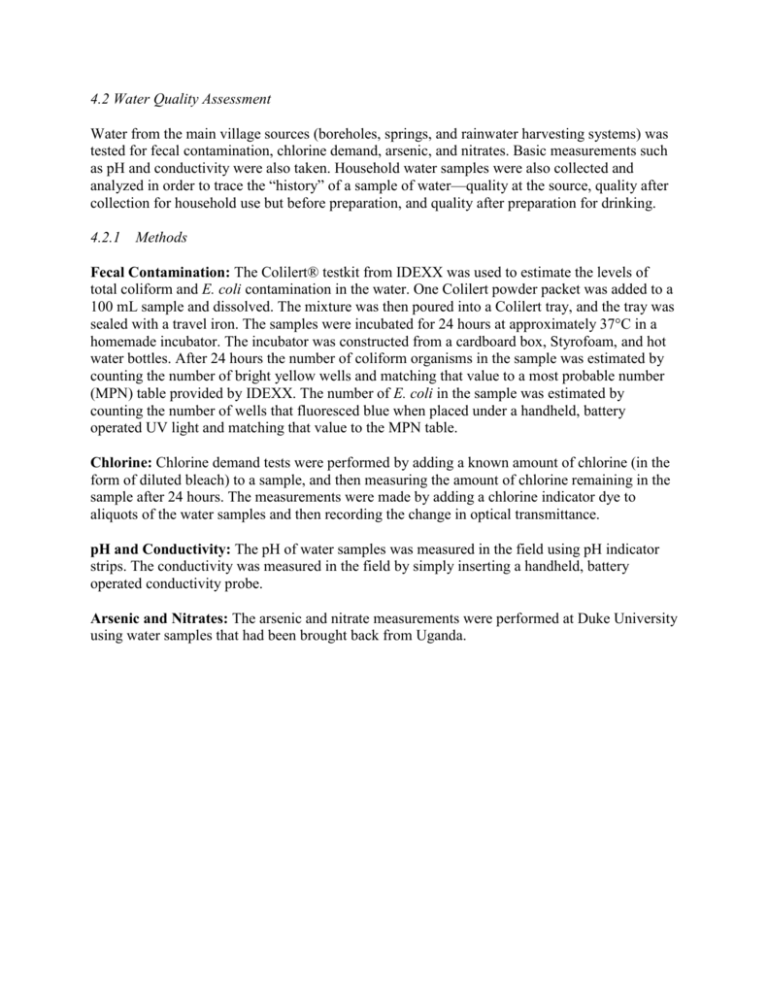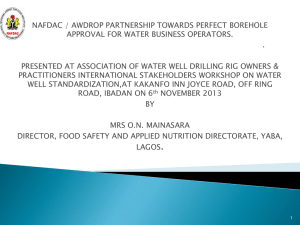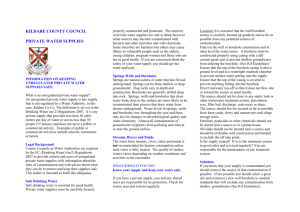4 - Duke University
advertisement

4.2 Water Quality Assessment Water from the main village sources (boreholes, springs, and rainwater harvesting systems) was tested for fecal contamination, chlorine demand, arsenic, and nitrates. Basic measurements such as pH and conductivity were also taken. Household water samples were also collected and analyzed in order to trace the “history” of a sample of water—quality at the source, quality after collection for household use but before preparation, and quality after preparation for drinking. 4.2.1 Methods Fecal Contamination: The Colilert® testkit from IDEXX was used to estimate the levels of total coliform and E. coli contamination in the water. One Colilert powder packet was added to a 100 mL sample and dissolved. The mixture was then poured into a Colilert tray, and the tray was sealed with a travel iron. The samples were incubated for 24 hours at approximately 37°C in a homemade incubator. The incubator was constructed from a cardboard box, Styrofoam, and hot water bottles. After 24 hours the number of coliform organisms in the sample was estimated by counting the number of bright yellow wells and matching that value to a most probable number (MPN) table provided by IDEXX. The number of E. coli in the sample was estimated by counting the number of wells that fluoresced blue when placed under a handheld, battery operated UV light and matching that value to the MPN table. Chlorine: Chlorine demand tests were performed by adding a known amount of chlorine (in the form of diluted bleach) to a sample, and then measuring the amount of chlorine remaining in the sample after 24 hours. The measurements were made by adding a chlorine indicator dye to aliquots of the water samples and then recording the change in optical transmittance. pH and Conductivity: The pH of water samples was measured in the field using pH indicator strips. The conductivity was measured in the field by simply inserting a handheld, battery operated conductivity probe. Arsenic and Nitrates: The arsenic and nitrate measurements were performed at Duke University using water samples that had been brought back from Uganda. 4.2.2 Results Average Total Coliform and E. coli Counts 250 Most Probable Number (MPN) (organisms/100 mL) Total Coliform Average E. coli Average 200 150 100 50 0 Boreholes, n=4 Springs, n=3 Rainwater Tanks, n=5 Source Figure 1. Summary plot of fecal contamination results. Household Unprepared Water, n=4 Household Prepared Water, n=7 Source Type Source Location Date (2006) Borehole Borehole Borehole Borehole Borehole Borehole Borehole Borehole Borehole Borehole Henry Hall Henry Hall Henry Hall Kanoni Kanoni Ryumba Kasaka Kasaka Kasaka Kasaka 18-May 22-May 25-May 18-May 21-May 21-May 21-May 22-May 24-May 25-May 3.1 0 Spring Katwekambwa 18-May Katwekambwa- 1:100 dilution Njabire Njabire Njabire Kanoni-Maddu 21-May 21-May 24-May 26-May 23-May 165.2 38.4 to 50.4 3.1 <1 13.7 27.1 5.9 Spring Spring Spring Spring Spring >200.5 118.4 to 200.5+ 8.7 <1 17.8 >200.5 Tank Kanoni-Maddu spring water carried to and stored in tank 23-May >200.5 18-May 21-May 24-May 22-May Rain-Roof-Tank Rain-Roof-Tank Rain-Roof-Tank Rain-Roof-Tank Rain-Roof-Tank Rain-Roof-Tank Drinking Drinking Drinking Drinking Drinking Drinking Drinking Drinking Drinking Drinking Drinking Drinking Drinking Kanoni Hospital Kanoni Hospital Kasaka house A Kasaka house B Primary School, Tank 1 (4 yrs old) Primary School, Tank 1 (new) Kasaka house B prepared water Waterguard Bag Water Kasaka house C boiled water Kasaka house C boiled water Kasaka house C unboiled water Kasaka house C unboiled water Kanoni-Maddu Bag Water Kasaka Secondary School Kettle House along road-- boiled water Kasaka House D Unboiled Kasaka House D Boiled Kasaka House E Unboiled Kasaka House E Boiled Table 1. On site water quality measurements. Coliforms (MPN) E. coli (MPN) <1 <1 3.1 7.5 <1 <1 <1 <1 1 <1 pH Conductivity (μS) Chlorine Used (mg/L) 180 6 5.9 5.6 5.1 5.8 5.1 4.5 184 89 108 3.3 2.75 98 1.6 5.4 4.8 4.8 53 68 70 4.5 63 27.1 5.6 83 165.2 59.1 >200.5 >200.5 3.1 <1 >200.6 <1 7.5 6.9 6 6.1 79 29 37 25-May 25-May >200.5 >200.5 >200.5 16.4 5.7 5.9 19 5 22-May 25-May 22-May 24-May >200.5 <1 >200.5 <1 25.4 <1 >200.5 <1 6.3 84 22-May >200.5 >200.5 24-May 23-May <1 1 5.8 64 23-May >200.5 >200.5 118.4 to 144.5 <1 to 2 7 77 24-May 25-May 26-May 27-May 28-May >200.5 >200.6 >200.7 >200.8 >200.9 <1 7.5 <1 3.1 <1 6.1 5.8 6.7 30 6 29 4.25 4.98 3.4 rep1 rep2 rep3 rep4 Source ug/L ug/L ug/L ug/L Kasaka borehole, filtered -1.2 -1.3 na na Kasaka borehole, unfiltered -1.9 -1.3 na na Kanoni hospital roof, filtered Primary school rainwater tank, filtered 0.2 -1.1 na na 0.7 -1.5 na na Henry Hall, filtered 0.4 1.0 na na Kanoni spring, filtered -0.6 -0.6 na na Njabire spring, filtered -1.4 -1.5 na na Henry Hall, unfiltered leaked out -0.9 na na 23.8 ppb external QC 24.6 24.8 25.6 24.3 Table 2. Arsenic measurements. Source Kasaka borehole, filtered Kasaka borehole, unfiltered Kanoni hospital roof, filtered Primary school rainwater tank, filtered Henry Hall, filtered Kanoni spring, filtered Njabire spring, filtered Henry Hall, unfiltered Table 3. Nitrate measurements. Nitrates (mg/L) 0.02 0.05 0.045 0.03 0.03 0.02 0.04 -- 4.2.3 Interpretation of Water Quality Results Fecal Contamination: As seen in Figure 1, the boreholes provide the only reliably uncontaminated water. EPA standards require samples of drinking water to have an E. coli count of zero, yet the water samples we collected from springs, rain water tanks, and unprepared household sources had average counts of over 50 organisms per 100 mL. The average for prepared water sources was lower (3.9), but still at an unsafe level. It is also important to note that in some cases, water that was collected from an initially pure source—the boreholes—gets contaminated with E. coli during collection or storage. This trend can be seen from the “household unprepared water” bar in Figure 1, since each of the households sampled in that data set gathered their water from a borehole that was shown to have no E. coli contamination. Chlorine Demand: The chlorine demand varied from source to source, as seen in Table 1. This was expected, since chlorine demand depends heavily on the turbidity of the water. Arsenic and Nitrates: For all sources measured the arsenic and nitrate levels were below the maximum allowable levels specified by the EPA (0.01 mg/L and 10 mg/L, respectively). RECS/ FUTURE IDEAS/PROJECTS - Point of use purification system, since contamination sometimes occurs after collection Chlorination, since it would provide longer lasting bacterial protection (as long as adequate residual levels) Flushing, filtering, cleaning, etc system to improve quality of rainwater harvested from roofs.








